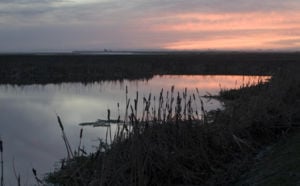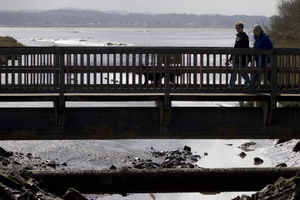Arcata Marsh and Wildlife Sanctuary
Arcata Marsh and Wildlife Sanctuary (AMWS) is located northwest of the oxidation ponds of the Arcata Wastewater treatment plant. The AMWS consists of three marshes: The George-Allen Marsh, Robert Gearheart and Dan Hauser Marshes. The AMWS is currently in the process of expanding the AMWS. This new area is called The McDaniel Slough Marsh Enhancement project and is located north of the Robert Gearheart pond. For more information on this addition, please visit: .

The AMWS is visited by over 150,000 people per year (City of Arcata)and is home to many different types of birds (for more information go to Arcata Marsh Birds) plants,fish. Passive recreation is common at the marsh. These activities include: bird watching, fishing and aquacture (for more information visit__________), walking, and scientific study are all possible uses of the marsh (for more information visit_______). Its is 154 acres big with 4.5 miles of trails (AMWS Map and Guide, April 1994), which can be assessed from South I, H and G streets.
Enhancement Ponds
Waster Water from the oxidation ponds is chlorinated (for more information about the chlorination process, please see Arcata Marsh Chlorination) and released into the enhancement ponds, but there are still high concentrations of algea that need to be removed. The influent has levels of BOD and Total Suspended Solids (SS) less than 10 mg/l and Total Inorganic Nitrogen (TIN) is less than 5mg/l (City of Arcata). This water is treated in the enhancement ponds where nitrogen fixing and the removal of phosporus is underway. This water starts in the George-Allen marsh, then travels to the Robert Gearheart Marsh and finally to the Dan Hauser marsh (City of Arcata). Effluent from the Dan Hauser marsh is treated by chlorine a second time and then is pumped back into the disinfection facility (City of Arcata)The enhancement ponds are 31 acres in size, are about 1.5 ft deep on average and with a retention time of average flow being nine days (City of Arcata).
Activites at AMWS
Bird Watching
Over 200 species of birds can be seen at AMWS. Fall and springtime are the best times to come and see the birds, especially during low tide (ACWS Map and Guide). Some of the most common birds that can be seen at the marsh include:
| Common Name | ||
|---|---|---|
| row 1, cell 1 | row 1, cell 2 | row 1, cell 3 |
| row 2, cell 1 | row 2, cell 2 | row 2, cell 3 |
- Black Bellied Plover
- Black Turnstone
- Dunlin
- Sanderling
- Long-billed Dowitcher
- Greater Yellow Legs
- Gulls:
- Herring
- Mew
- Glaucous
- Californian
- Bonaparete’s
- Brown Pelican
- Cormorants
- Pelagic
- Double-crested
- Brandt’s
- Scoters
- White winged
- Surf
- Common
- Red-Breasted Merganser
- Northern Phalarope
- Marbled Godwit
- Long billed Curlew
- Whimbrel
- Canadian Goose
- Common Loon
- American Coot
- Merlin
- Grebes
- Western
- Red-necked
- Horned
- Eared
- Forster’s Tern
- Belted King Fisher
- American GoldFinch
- Tree Swallow
- Short-Eared Owl
- Swipe
- Red-billed Grebe
- Sora
- Marsh Wren
- American Bettern
- Wilson ’s Warbler
- Savannah Sparrow
- Red-winged blackbird
- Song Sparrow
- Virginia Rail
- Least Bittern
- Green-backed Heron
- Black-crowned Night Heron
- Osprey
- Greater Scaup
- Pintail
- Redhead
- Green-winged Teal
- Mallard
- Canvasback
- Northern Shoveler
- Bufflehead
- Ruddy Duck
- Great Blue Heron
- American Avocites
- Snowy Egret
- Peregrene Falcon
- Great Egret
- Willet
- Western Sand Piper
- Black bellied Plover
- Least Sandpiper
- Semi-Palmated Plover
- Killdeer
- Redknot
-AMWS
Fishing and Aqua-Culture
The AMWS is home to many different species of fish. These fish include
- Coho Salmon
- Cutthroat Trout
- Rainbow Trout
- Chinock Salmon
- White Sturgeon
-ERE Dept
Fishing for trout is permitted year round at the Franklin R. Klopp Recreation Lake. Some rules and restrictions apply. For more information about these and other services, please contact Arcata Environmental Services at (707)822-8184.
Plants
Friends of Arcata Marsh (FOAM) has complied a list of Common Plants of the Arcata Marsh. These plants include:
| Trees and Shrubs | Wetland Plants | Other Plants |
|---|---|---|
| Big-leaf Maple, Blue Blossom, California Blackberry, Canyon Gooseberry, Cascara Sagrada, Coast Redwood, Coast Willow, Coyote Brush, Himalayan Blackberry, Monterey Pine, Port Orford Cedar, Red Alder, Red Elderberry, Red Flowering Currant, Sitka Spruce, Thimbleberry, Wax Myrtle | Brass Button, Bulrush, Broadleaf Cattail, Common Mare’s-tail, Common Rush, Cordgrass, Duckweed, Jaumea, Marsh Pennywort, Marsh Rosemary, Pickleweed, Saltbrush, Sea-Arrow-grass, Umbrella sedge, Water Parsley, Water Plantain | Birdfoot trefoil, Bracken Fern, Bull Thistle, California Aster, California Poppy, Cat’s Ear, Cinquefoil, Common Horsetail, Common Plantain, Cow Parsnip, Creeping Buttercup, Curly Dock, Douglas Iris, Evening Primrose, Fennel, Fiel Mustard, Foxglove, Gumplant, Lupine, Oxeye Daisey, Pampas Grass, Pearly Everlasting, Poison Hemlock, Rattlesnake Grass, Red Clover, Roadside Everlast Pea, Queen Anne’s Lace, Sheep Sorrel, Sword Fern, Teasel, Yarrow, Yellow Parentucellia |
-Source: Melinda Bailey and Louise Watson (7/28/99)
===Activities===

City of Arcata Volunteer Days:
- Saturday, September 20, 2008: Removal of non-native plants (9am-1pm) Sponsored by Humboldt United Way- “Day of Caring”
- Saturday, October 11, 2008: Non Native Plant Removal (9am-1pm). Sponsored by: FOAM and CNPS.
Volunteers are expected to wear work clothes and boots. The must sign a liability release form in order to participate. The City of Arcata will provide gloves, tools, first aid kits, snacks and beverages. They will also present a safety talk and too-use instructions prior to work. Contact (707)825-2163 for more information about volunteering. -Source: City of Arcata’s Forest and Marsh Volunteer Workday Schedule 2008-2009 (2/14/08)
Aleutian Goose Festival: A Celebration of Wildness (March 28-31,2008) For more information visit: [www.aleutiangoosefestival.org] or call 800-343-8300
13th Annual Godwit Days: Spring Migration Bird Festival (April 17th-23, 2008) Keynote Speakers: Dr. Andrew Farnsworth (of Cornell Lab of Ornithology. Spotlight Organization: Friends of the Dunes Around 100 field trips and workshops, bird fair, art show and live birds of prey. For more information visit [www.godwitdays.com] or call 1-800-908-WING.
Bilibliography
- Bailey, Melinda and Watson, Louise. “Common Plants of Arcata Marsh” Friends of
Arcata Marsh. July 28, 1999.
- “Arcata Marsh and Wildlife Sanctuary: Map and Guide.” April 1994
- “City of Arcata’s Forest and Marsh Volunteer Workday Schedule 2008-2009.” February 14, 2008.
- "A Natural System for Wastewater Reclamation and Resouce Enhancement." Arcata, California. Friends of Arcata Mash
- ERE department. “Arcata Marsh and Wildlife Sanctuary’s Aquaculture Project.” [www.humboldt.edu/~ere_dept/marsh/aquaculture.html]